Developing New Business and Ventures: Nokia's Entrepreneurial Analysis
VerifiedAdded on 2020/04/01
|6
|1552
|139
Report
AI Summary
This report provides an in-depth entrepreneurial analysis of Nokia's strategic decision to re-introduce its range of smartphones. It begins with an abstract highlighting the key entrepreneurial qualities and characteristics. The report then provides background information on Nokia's business and its new product, the Nokia 8, discussing the challenges posed by competitors like Apple and Samsung. The core of the report focuses on the application of the opportunity-based theory, examining how Nokia identified and exploited opportunities within the changing technological landscape and consumer preferences. The report discusses the evolution of Nokia's approach, from the initial introduction of the Nokia 9210 to its adaptation to the Android operating system. The conclusion emphasizes the importance of entrepreneurial management in achieving success and highlights the need for further research to understand the impact of various aspects of entrepreneurial administration. The report references several academic sources to support its analysis.
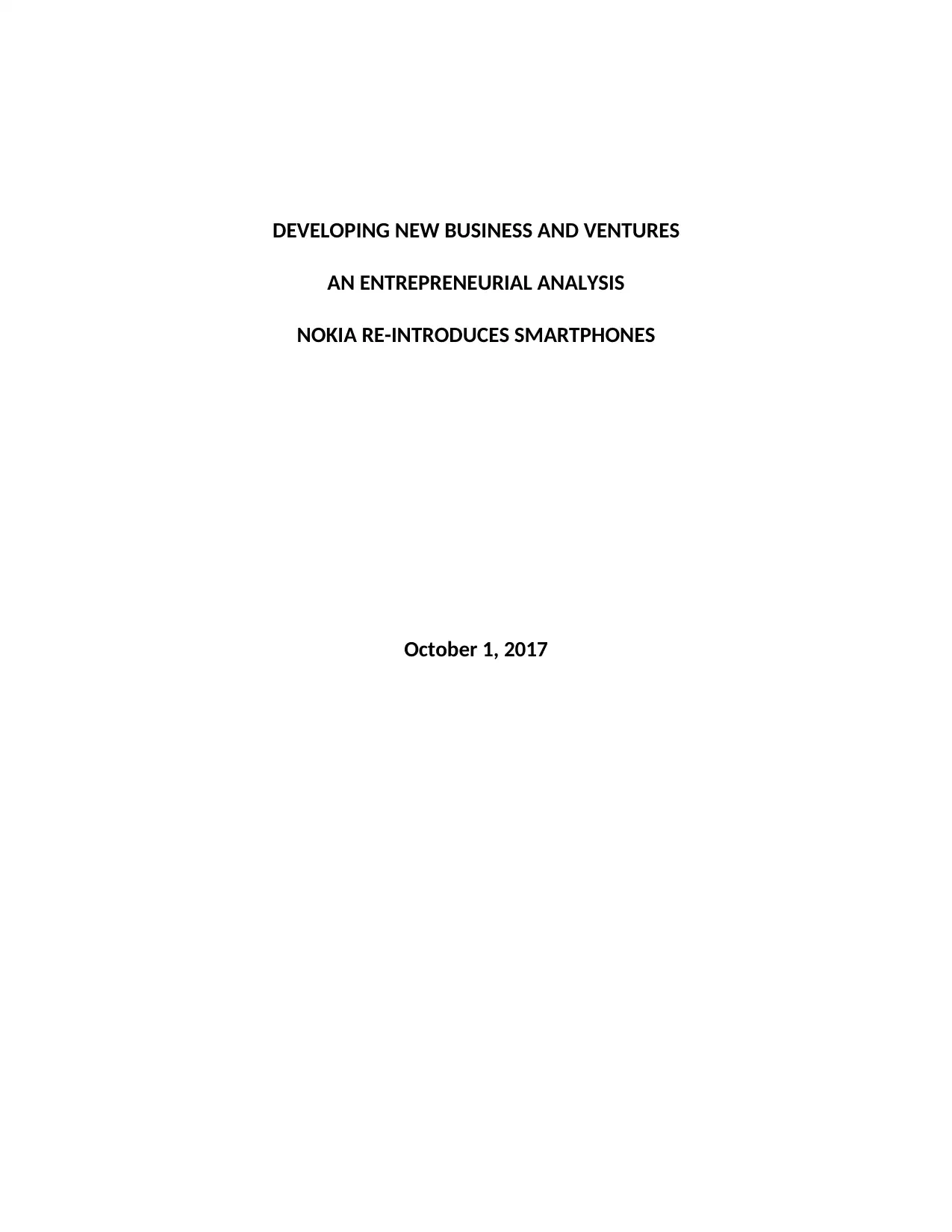
DEVELOPING NEW BUSINESS AND VENTURES
AN ENTREPRENEURIAL ANALYSIS
NOKIA RE-INTRODUCES SMARTPHONES
October 1, 2017
AN ENTREPRENEURIAL ANALYSIS
NOKIA RE-INTRODUCES SMARTPHONES
October 1, 2017
Paraphrase This Document
Need a fresh take? Get an instant paraphrase of this document with our AI Paraphraser
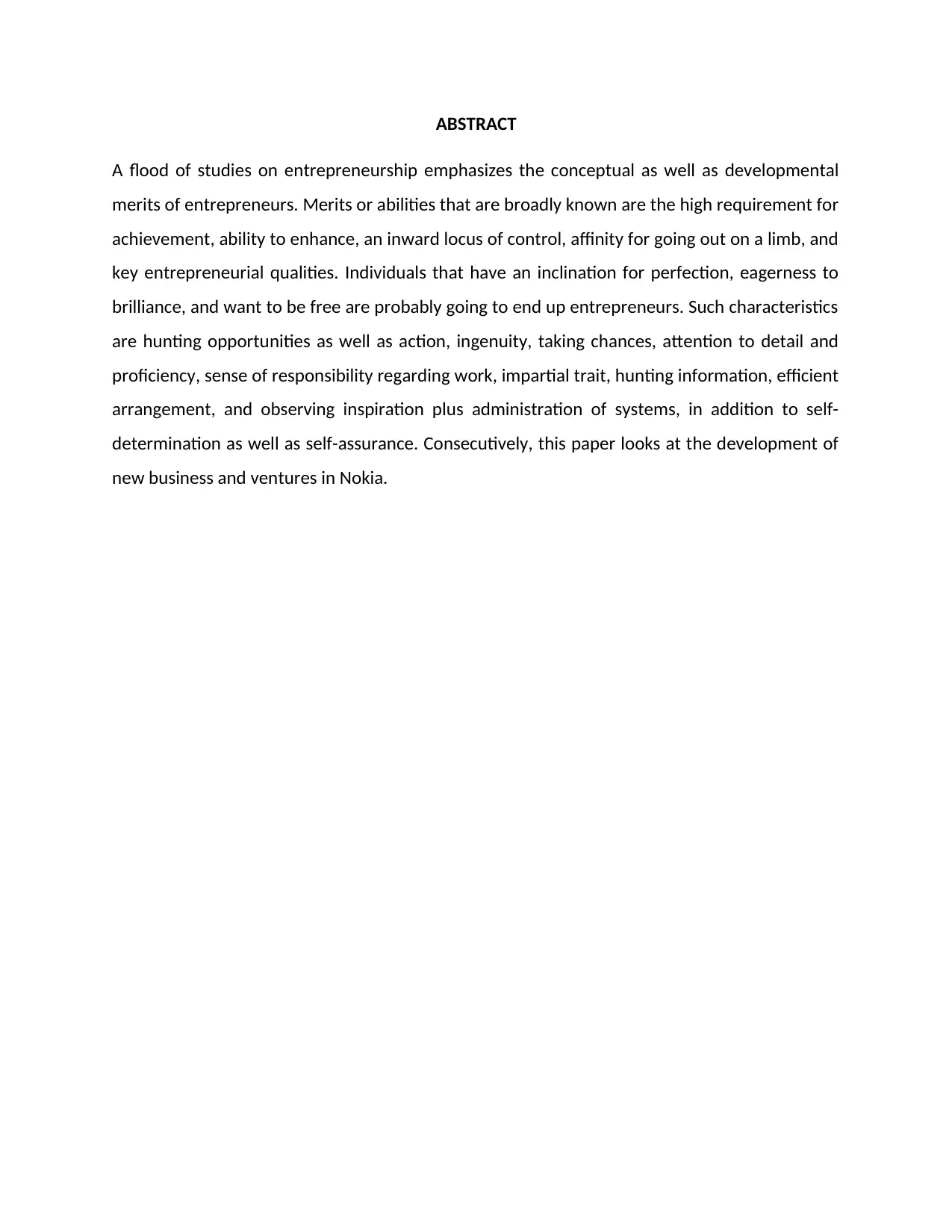
ABSTRACT
A flood of studies on entrepreneurship emphasizes the conceptual as well as developmental
merits of entrepreneurs. Merits or abilities that are broadly known are the high requirement for
achievement, ability to enhance, an inward locus of control, affinity for going out on a limb, and
key entrepreneurial qualities. Individuals that have an inclination for perfection, eagerness to
brilliance, and want to be free are probably going to end up entrepreneurs. Such characteristics
are hunting opportunities as well as action, ingenuity, taking chances, attention to detail and
proficiency, sense of responsibility regarding work, impartial trait, hunting information, efficient
arrangement, and observing inspiration plus administration of systems, in addition to self-
determination as well as self-assurance. Consecutively, this paper looks at the development of
new business and ventures in Nokia.
A flood of studies on entrepreneurship emphasizes the conceptual as well as developmental
merits of entrepreneurs. Merits or abilities that are broadly known are the high requirement for
achievement, ability to enhance, an inward locus of control, affinity for going out on a limb, and
key entrepreneurial qualities. Individuals that have an inclination for perfection, eagerness to
brilliance, and want to be free are probably going to end up entrepreneurs. Such characteristics
are hunting opportunities as well as action, ingenuity, taking chances, attention to detail and
proficiency, sense of responsibility regarding work, impartial trait, hunting information, efficient
arrangement, and observing inspiration plus administration of systems, in addition to self-
determination as well as self-assurance. Consecutively, this paper looks at the development of
new business and ventures in Nokia.
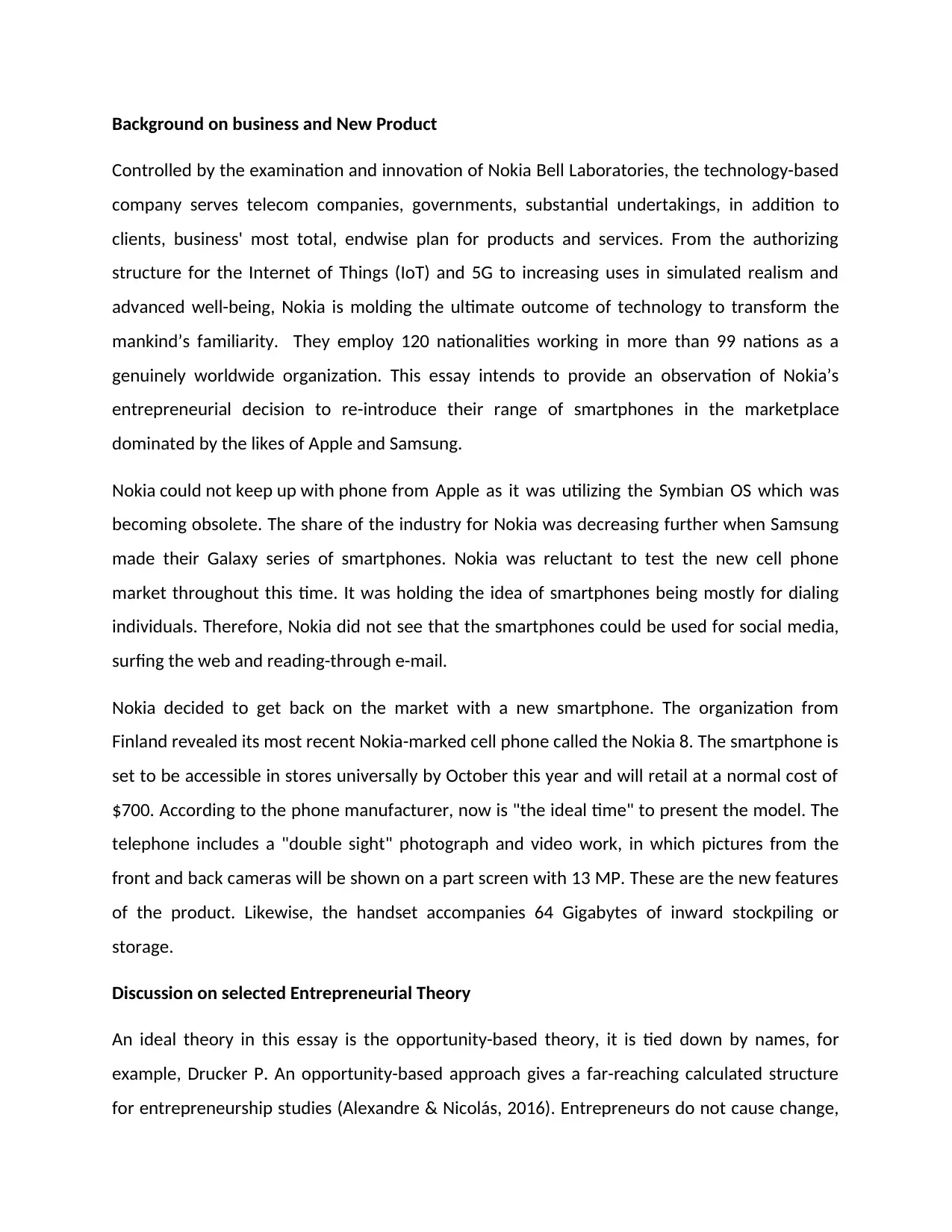
Background on business and New Product
Controlled by the examination and innovation of Nokia Bell Laboratories, the technology-based
company serves telecom companies, governments, substantial undertakings, in addition to
clients, business' most total, endwise plan for products and services. From the authorizing
structure for the Internet of Things (IoT) and 5G to increasing uses in simulated realism and
advanced well-being, Nokia is molding the ultimate outcome of technology to transform the
mankind’s familiarity. They employ 120 nationalities working in more than 99 nations as a
genuinely worldwide organization. This essay intends to provide an observation of Nokia’s
entrepreneurial decision to re-introduce their range of smartphones in the marketplace
dominated by the likes of Apple and Samsung.
Nokia could not keep up with phone from Apple as it was utilizing the Symbian OS which was
becoming obsolete. The share of the industry for Nokia was decreasing further when Samsung
made their Galaxy series of smartphones. Nokia was reluctant to test the new cell phone
market throughout this time. It was holding the idea of smartphones being mostly for dialing
individuals. Therefore, Nokia did not see that the smartphones could be used for social media,
surfing the web and reading-through e-mail.
Nokia decided to get back on the market with a new smartphone. The organization from
Finland revealed its most recent Nokia-marked cell phone called the Nokia 8. The smartphone is
set to be accessible in stores universally by October this year and will retail at a normal cost of
$700. According to the phone manufacturer, now is "the ideal time" to present the model. The
telephone includes a "double sight" photograph and video work, in which pictures from the
front and back cameras will be shown on a part screen with 13 MP. These are the new features
of the product. Likewise, the handset accompanies 64 Gigabytes of inward stockpiling or
storage.
Discussion on selected Entrepreneurial Theory
An ideal theory in this essay is the opportunity-based theory, it is tied down by names, for
example, Drucker P. An opportunity-based approach gives a far-reaching calculated structure
for entrepreneurship studies (Alexandre & Nicolás, 2016). Entrepreneurs do not cause change,
Controlled by the examination and innovation of Nokia Bell Laboratories, the technology-based
company serves telecom companies, governments, substantial undertakings, in addition to
clients, business' most total, endwise plan for products and services. From the authorizing
structure for the Internet of Things (IoT) and 5G to increasing uses in simulated realism and
advanced well-being, Nokia is molding the ultimate outcome of technology to transform the
mankind’s familiarity. They employ 120 nationalities working in more than 99 nations as a
genuinely worldwide organization. This essay intends to provide an observation of Nokia’s
entrepreneurial decision to re-introduce their range of smartphones in the marketplace
dominated by the likes of Apple and Samsung.
Nokia could not keep up with phone from Apple as it was utilizing the Symbian OS which was
becoming obsolete. The share of the industry for Nokia was decreasing further when Samsung
made their Galaxy series of smartphones. Nokia was reluctant to test the new cell phone
market throughout this time. It was holding the idea of smartphones being mostly for dialing
individuals. Therefore, Nokia did not see that the smartphones could be used for social media,
surfing the web and reading-through e-mail.
Nokia decided to get back on the market with a new smartphone. The organization from
Finland revealed its most recent Nokia-marked cell phone called the Nokia 8. The smartphone is
set to be accessible in stores universally by October this year and will retail at a normal cost of
$700. According to the phone manufacturer, now is "the ideal time" to present the model. The
telephone includes a "double sight" photograph and video work, in which pictures from the
front and back cameras will be shown on a part screen with 13 MP. These are the new features
of the product. Likewise, the handset accompanies 64 Gigabytes of inward stockpiling or
storage.
Discussion on selected Entrepreneurial Theory
An ideal theory in this essay is the opportunity-based theory, it is tied down by names, for
example, Drucker P. An opportunity-based approach gives a far-reaching calculated structure
for entrepreneurship studies (Alexandre & Nicolás, 2016). Entrepreneurs do not cause change,
⊘ This is a preview!⊘
Do you want full access?
Subscribe today to unlock all pages.

Trusted by 1+ million students worldwide
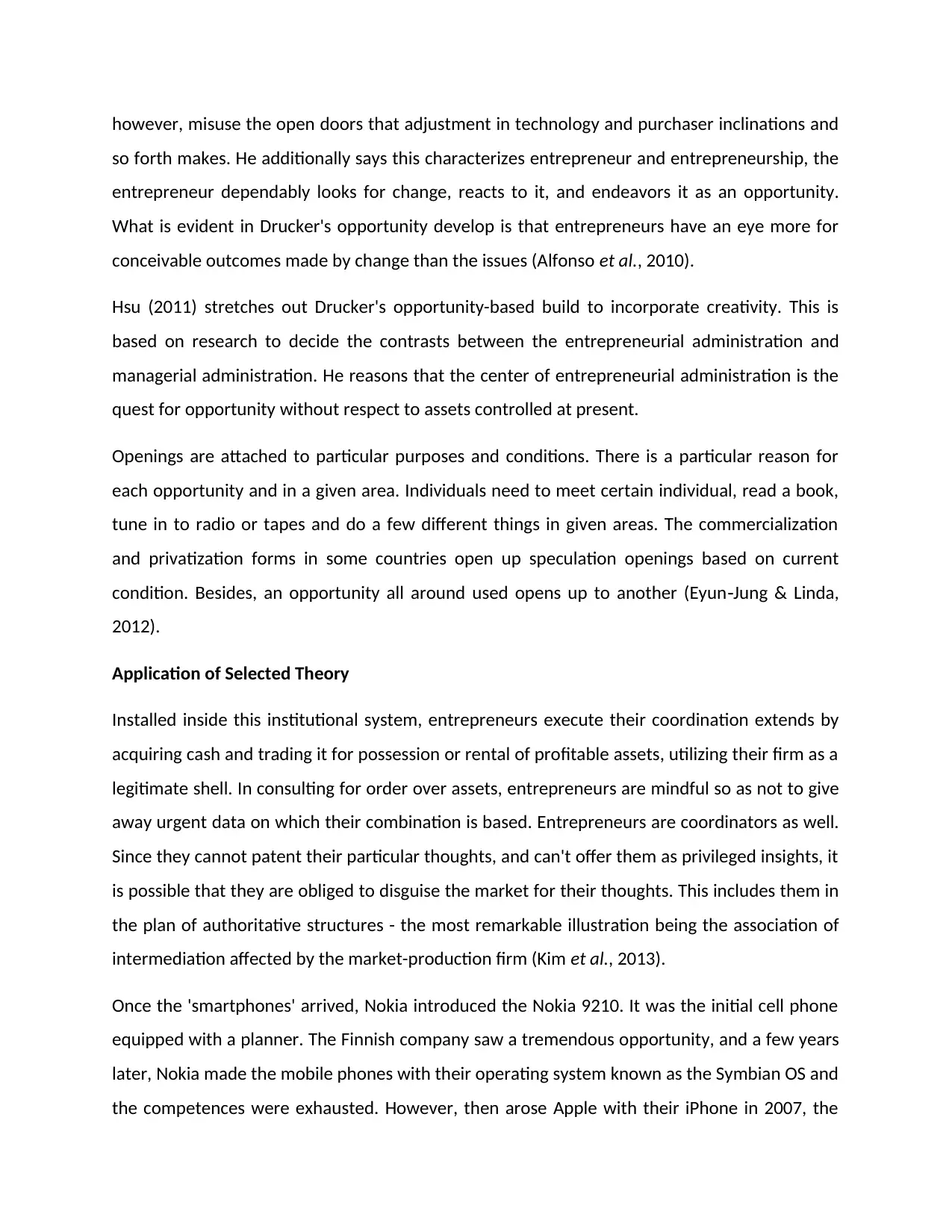
however, misuse the open doors that adjustment in technology and purchaser inclinations and
so forth makes. He additionally says this characterizes entrepreneur and entrepreneurship, the
entrepreneur dependably looks for change, reacts to it, and endeavors it as an opportunity.
What is evident in Drucker's opportunity develop is that entrepreneurs have an eye more for
conceivable outcomes made by change than the issues (Alfonso et al., 2010).
Hsu (2011) stretches out Drucker's opportunity-based build to incorporate creativity. This is
based on research to decide the contrasts between the entrepreneurial administration and
managerial administration. He reasons that the center of entrepreneurial administration is the
quest for opportunity without respect to assets controlled at present.
Openings are attached to particular purposes and conditions. There is a particular reason for
each opportunity and in a given area. Individuals need to meet certain individual, read a book,
tune in to radio or tapes and do a few different things in given areas. The commercialization
and privatization forms in some countries open up speculation openings based on current
condition. Besides, an opportunity all around used opens up to another (Eyun Jung & Linda,‐
2012).
Application of Selected Theory
Installed inside this institutional system, entrepreneurs execute their coordination extends by
acquiring cash and trading it for possession or rental of profitable assets, utilizing their firm as a
legitimate shell. In consulting for order over assets, entrepreneurs are mindful so as not to give
away urgent data on which their combination is based. Entrepreneurs are coordinators as well.
Since they cannot patent their particular thoughts, and can't offer them as privileged insights, it
is possible that they are obliged to disguise the market for their thoughts. This includes them in
the plan of authoritative structures - the most remarkable illustration being the association of
intermediation affected by the market-production firm (Kim et al., 2013).
Once the 'smartphones' arrived, Nokia introduced the Nokia 9210. It was the initial cell phone
equipped with a planner. The Finnish company saw a tremendous opportunity, and a few years
later, Nokia made the mobile phones with their operating system known as the Symbian OS and
the competences were exhausted. However, then arose Apple with their iPhone in 2007, the
so forth makes. He additionally says this characterizes entrepreneur and entrepreneurship, the
entrepreneur dependably looks for change, reacts to it, and endeavors it as an opportunity.
What is evident in Drucker's opportunity develop is that entrepreneurs have an eye more for
conceivable outcomes made by change than the issues (Alfonso et al., 2010).
Hsu (2011) stretches out Drucker's opportunity-based build to incorporate creativity. This is
based on research to decide the contrasts between the entrepreneurial administration and
managerial administration. He reasons that the center of entrepreneurial administration is the
quest for opportunity without respect to assets controlled at present.
Openings are attached to particular purposes and conditions. There is a particular reason for
each opportunity and in a given area. Individuals need to meet certain individual, read a book,
tune in to radio or tapes and do a few different things in given areas. The commercialization
and privatization forms in some countries open up speculation openings based on current
condition. Besides, an opportunity all around used opens up to another (Eyun Jung & Linda,‐
2012).
Application of Selected Theory
Installed inside this institutional system, entrepreneurs execute their coordination extends by
acquiring cash and trading it for possession or rental of profitable assets, utilizing their firm as a
legitimate shell. In consulting for order over assets, entrepreneurs are mindful so as not to give
away urgent data on which their combination is based. Entrepreneurs are coordinators as well.
Since they cannot patent their particular thoughts, and can't offer them as privileged insights, it
is possible that they are obliged to disguise the market for their thoughts. This includes them in
the plan of authoritative structures - the most remarkable illustration being the association of
intermediation affected by the market-production firm (Kim et al., 2013).
Once the 'smartphones' arrived, Nokia introduced the Nokia 9210. It was the initial cell phone
equipped with a planner. The Finnish company saw a tremendous opportunity, and a few years
later, Nokia made the mobile phones with their operating system known as the Symbian OS and
the competences were exhausted. However, then arose Apple with their iPhone in 2007, the
Paraphrase This Document
Need a fresh take? Get an instant paraphrase of this document with our AI Paraphraser
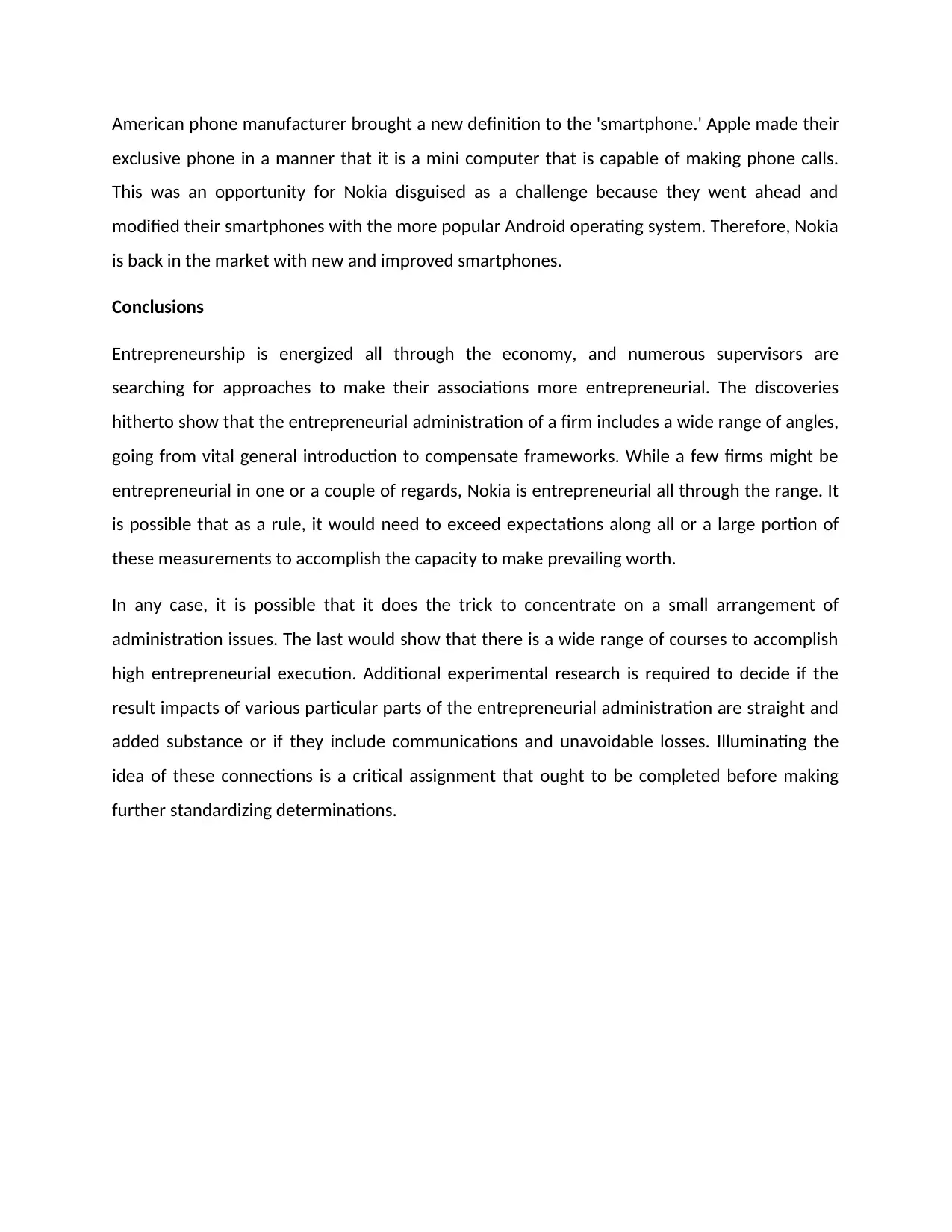
American phone manufacturer brought a new definition to the 'smartphone.' Apple made their
exclusive phone in a manner that it is a mini computer that is capable of making phone calls.
This was an opportunity for Nokia disguised as a challenge because they went ahead and
modified their smartphones with the more popular Android operating system. Therefore, Nokia
is back in the market with new and improved smartphones.
Conclusions
Entrepreneurship is energized all through the economy, and numerous supervisors are
searching for approaches to make their associations more entrepreneurial. The discoveries
hitherto show that the entrepreneurial administration of a firm includes a wide range of angles,
going from vital general introduction to compensate frameworks. While a few firms might be
entrepreneurial in one or a couple of regards, Nokia is entrepreneurial all through the range. It
is possible that as a rule, it would need to exceed expectations along all or a large portion of
these measurements to accomplish the capacity to make prevailing worth.
In any case, it is possible that it does the trick to concentrate on a small arrangement of
administration issues. The last would show that there is a wide range of courses to accomplish
high entrepreneurial execution. Additional experimental research is required to decide if the
result impacts of various particular parts of the entrepreneurial administration are straight and
added substance or if they include communications and unavoidable losses. Illuminating the
idea of these connections is a critical assignment that ought to be completed before making
further standardizing determinations.
exclusive phone in a manner that it is a mini computer that is capable of making phone calls.
This was an opportunity for Nokia disguised as a challenge because they went ahead and
modified their smartphones with the more popular Android operating system. Therefore, Nokia
is back in the market with new and improved smartphones.
Conclusions
Entrepreneurship is energized all through the economy, and numerous supervisors are
searching for approaches to make their associations more entrepreneurial. The discoveries
hitherto show that the entrepreneurial administration of a firm includes a wide range of angles,
going from vital general introduction to compensate frameworks. While a few firms might be
entrepreneurial in one or a couple of regards, Nokia is entrepreneurial all through the range. It
is possible that as a rule, it would need to exceed expectations along all or a large portion of
these measurements to accomplish the capacity to make prevailing worth.
In any case, it is possible that it does the trick to concentrate on a small arrangement of
administration issues. The last would show that there is a wide range of courses to accomplish
high entrepreneurial execution. Additional experimental research is required to decide if the
result impacts of various particular parts of the entrepreneurial administration are straight and
added substance or if they include communications and unavoidable losses. Illuminating the
idea of these connections is a critical assignment that ought to be completed before making
further standardizing determinations.
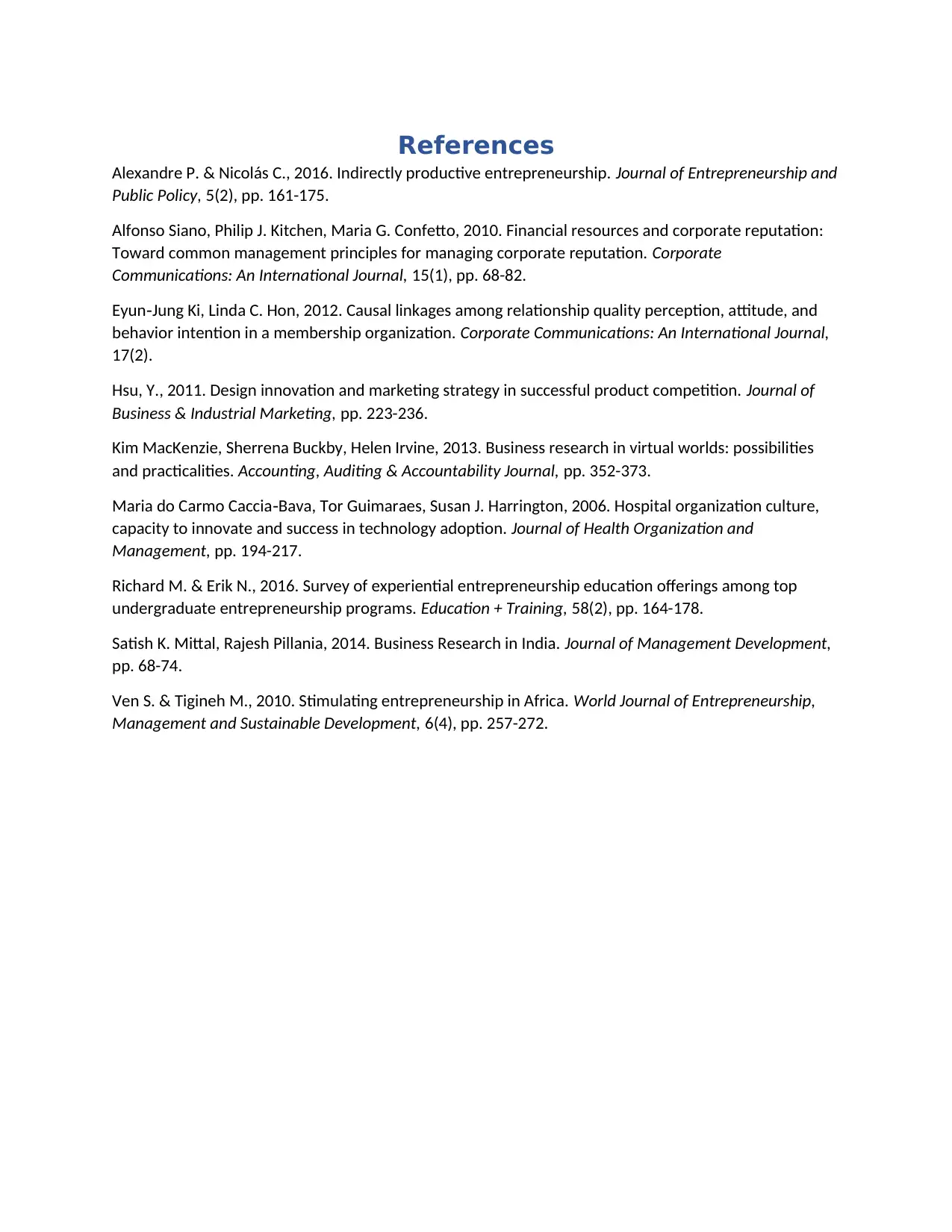
References
Alexandre P. & Nicolás C., 2016. Indirectly productive entrepreneurship. Journal of Entrepreneurship and
Public Policy, 5(2), pp. 161-175.
Alfonso Siano, Philip J. Kitchen, Maria G. Confetto, 2010. Financial resources and corporate reputation:
Toward common management principles for managing corporate reputation. Corporate
Communications: An International Journal, 15(1), pp. 68-82.
Eyun Jung Ki, Linda C. Hon, 2012. Causal linkages among relationship quality perception, attitude, and‐
behavior intention in a membership organization. Corporate Communications: An International Journal,
17(2).
Hsu, Y., 2011. Design innovation and marketing strategy in successful product competition. Journal of
Business & Industrial Marketing, pp. 223-236.
Kim MacKenzie, Sherrena Buckby, Helen Irvine, 2013. Business research in virtual worlds: possibilities
and practicalities. Accounting, Auditing & Accountability Journal, pp. 352-373.
Maria do Carmo Caccia Bava, Tor Guimaraes, Susan J. Harrington, 2006. Hospital organization culture,‐
capacity to innovate and success in technology adoption. Journal of Health Organization and
Management, pp. 194-217.
Richard M. & Erik N., 2016. Survey of experiential entrepreneurship education offerings among top
undergraduate entrepreneurship programs. Education + Training, 58(2), pp. 164-178.
Satish K. Mittal, Rajesh Pillania, 2014. Business Research in India. Journal of Management Development,
pp. 68-74.
Ven S. & Tigineh M., 2010. Stimulating entrepreneurship in Africa. World Journal of Entrepreneurship,
Management and Sustainable Development, 6(4), pp. 257-272.
Alexandre P. & Nicolás C., 2016. Indirectly productive entrepreneurship. Journal of Entrepreneurship and
Public Policy, 5(2), pp. 161-175.
Alfonso Siano, Philip J. Kitchen, Maria G. Confetto, 2010. Financial resources and corporate reputation:
Toward common management principles for managing corporate reputation. Corporate
Communications: An International Journal, 15(1), pp. 68-82.
Eyun Jung Ki, Linda C. Hon, 2012. Causal linkages among relationship quality perception, attitude, and‐
behavior intention in a membership organization. Corporate Communications: An International Journal,
17(2).
Hsu, Y., 2011. Design innovation and marketing strategy in successful product competition. Journal of
Business & Industrial Marketing, pp. 223-236.
Kim MacKenzie, Sherrena Buckby, Helen Irvine, 2013. Business research in virtual worlds: possibilities
and practicalities. Accounting, Auditing & Accountability Journal, pp. 352-373.
Maria do Carmo Caccia Bava, Tor Guimaraes, Susan J. Harrington, 2006. Hospital organization culture,‐
capacity to innovate and success in technology adoption. Journal of Health Organization and
Management, pp. 194-217.
Richard M. & Erik N., 2016. Survey of experiential entrepreneurship education offerings among top
undergraduate entrepreneurship programs. Education + Training, 58(2), pp. 164-178.
Satish K. Mittal, Rajesh Pillania, 2014. Business Research in India. Journal of Management Development,
pp. 68-74.
Ven S. & Tigineh M., 2010. Stimulating entrepreneurship in Africa. World Journal of Entrepreneurship,
Management and Sustainable Development, 6(4), pp. 257-272.
⊘ This is a preview!⊘
Do you want full access?
Subscribe today to unlock all pages.

Trusted by 1+ million students worldwide
1 out of 6
Your All-in-One AI-Powered Toolkit for Academic Success.
+13062052269
info@desklib.com
Available 24*7 on WhatsApp / Email
![[object Object]](/_next/static/media/star-bottom.7253800d.svg)
Unlock your academic potential
Copyright © 2020–2025 A2Z Services. All Rights Reserved. Developed and managed by ZUCOL.